Illicit diamond diggers risk their lives in South Africa, where mineral wealth was not equally shared.
A thin, dreadlocked man, middle-aged but fit and ropey, spends his days digging for diamonds in South Africa’s Namaqualand desert. That he is known simply as Rasta, in a region home to several hundred Rastafarians, indicates the sweep of his reputation. A prospector and geologist with no formal training, he has constructed dozens of tunnels in the last 15 years, granting diggers access to untold thousands of diamonds. Working by hand with rudimentary equipment, he excavates for weeks at a time, hoping to strike layers of diamond-bearing gravel. His operations are unlawful and exceedingly dangerous. A tunnel he helped open in 2012 collapsed after a few months, killing 10 men.
Though that disaster alarmed him, Rasta has not stopped digging. He is among the best known diggers in an area where illicit mining is endemic: a folkloric character in a marginal resource economy, renowned for his commitment and apparent fearlessness. Mine closures a decade ago left a legacy of chronic unemployment in Namaqualand, an arid, sparsely populated region with few alternative industries. Though legal mining is no longer profitable enough for companies to employ large numbers of people, enough diamonds remain in the ground to lure hundreds of diggers to risk their lives and break the law.

A week before Christmas, on a scorching summer afternoon, I join Rasta inside one of his tunnels. A spate of police clampdowns on illegal digging has infuriated him, and he wants me to comprehend the physical difficulty of his work. We drive into an abandoned mine pit the size of a football stadium, its bare, chalk-colored walls reflecting the noonday heat. Though mining companies are legally required to rehabilitate old sites, created by stripping away tons of sediment from the bedrock, vast expanses of the Namaqualand diamond fields, scarred and devoid of vegetation, illustrate how seldom this remedial action takes place. Rasta, who is excitable and speaks at a blistering pace, directs us towards a crumbling cliff, six stories high. At its base, obscured by a heap of red sand, stands the entrance to a narrow shaft.
He bends himself inside the opening to the tunnel, balancing on a ledge. “I don’t care anymore,” he mutters. “People must see what we do to survive. Fuck this government.” He descends fast, straddling the sheer drop, his hands and feet finding shallow depressions in the walls. The earth muffles his voice. His outline blurs in the dark. Then it is time to follow. My palms are clammy and I’m afraid I’ll slip, but the gravel, despite sifting loose in places, holds firm. At the bottom, 20 feet from the surface, it smells like wet clay.
On all fours, we crawl into a tight passage, moving in single file. It’s too tight to turn around. The tunnel curves wherever the diggers, working with hammers and long chisels, have struck rock. Usually one man digs at a time, loosening gravel; his companions haul the gravel to the surface in large sacks, either discarding it or setting it aside for processing.
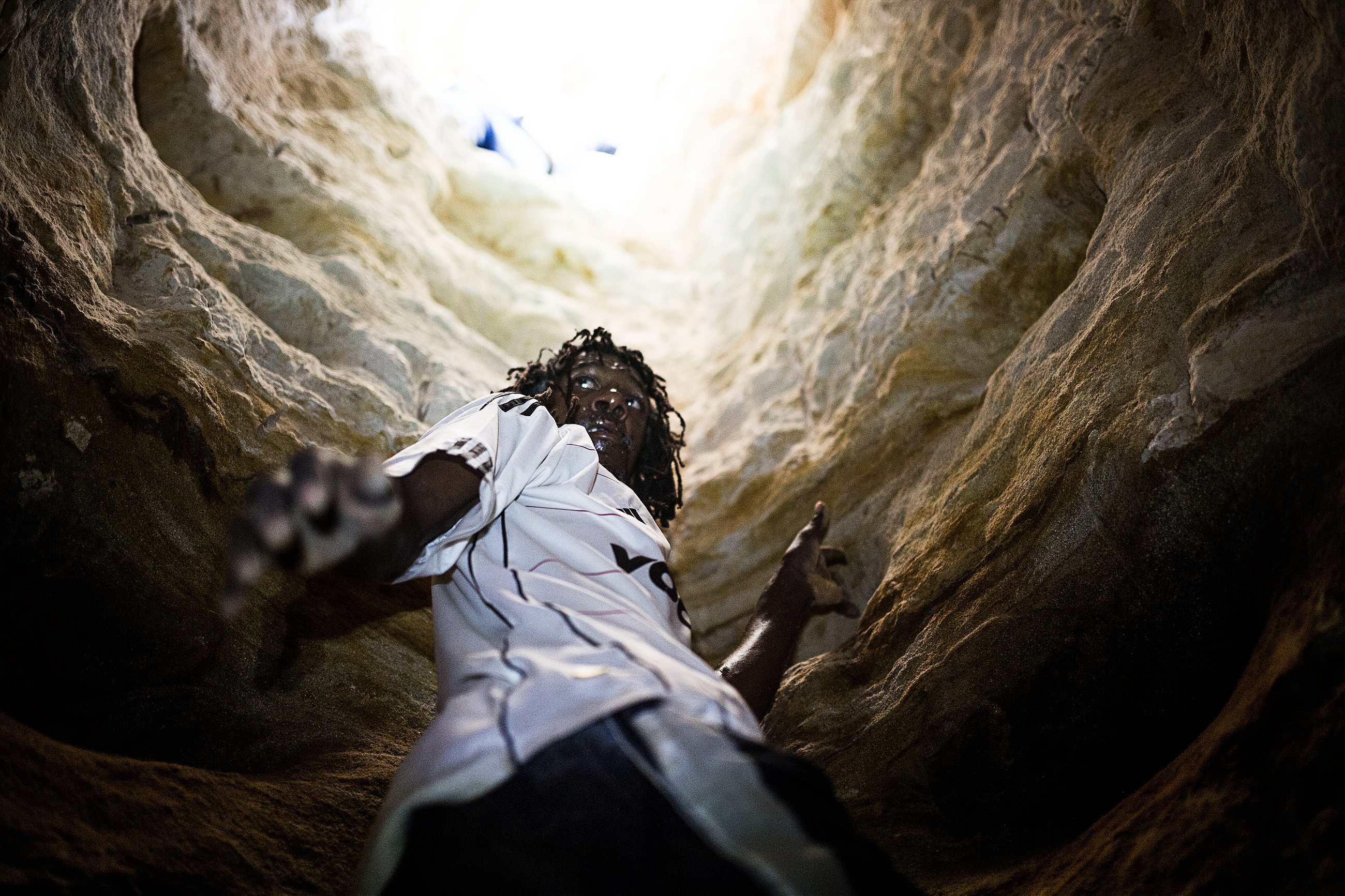
Rivers carried diamonds to the west coast millions of years ago, redistributing portions of the rich inland deposits, first discovered in Kimberley, that triggered South Africa’s diamond rush of the late 19th century and rapidly grew the national economy. In Namaqualand, these diamonds settled in riverbeds and rocky hollows, were later covered by sand, and today, in the wake of a diminished legal mining industry, await diggers bold or desperate enough to retrieve them.
Rasta stops when he reaches the end of the tunnel, more than 50 feet from the shaft. The passage has widened into a small chamber; boulders the size of bread loaves are piled to one side. He crouches in front of the face and points to a seam of darker rock. “This is the belt,” he says, wielding a chisel that had been left underground. “When you hit this, you know the mine is going to pay.”
Working with six other men, he’d found four diamonds in an adjacent tunnel two weeks earlier. They’d sold the diamonds, measuring between 0.60 and 1.10 carats, for R25,000 ($1800 USD)—a fraction of their true value, undercut by the illicit nature of the deal. But I’m struggling to focus on the details. The air is heavy and damp, making breathing difficult. Sweat drips from Rasta’s brow. The toil of working inside that cramped burrow for hours on end, of breaking compacted earth and dragging it out, bag by bag, is unimaginable. I let the others pass me on the way out and sit a minute in undiluted blackness, drawing stale breaths. When I climb up and step into the bleached sunlight, where the temperature exceeds 100 degrees Fahrenheit, the air feels deliciously fresh.
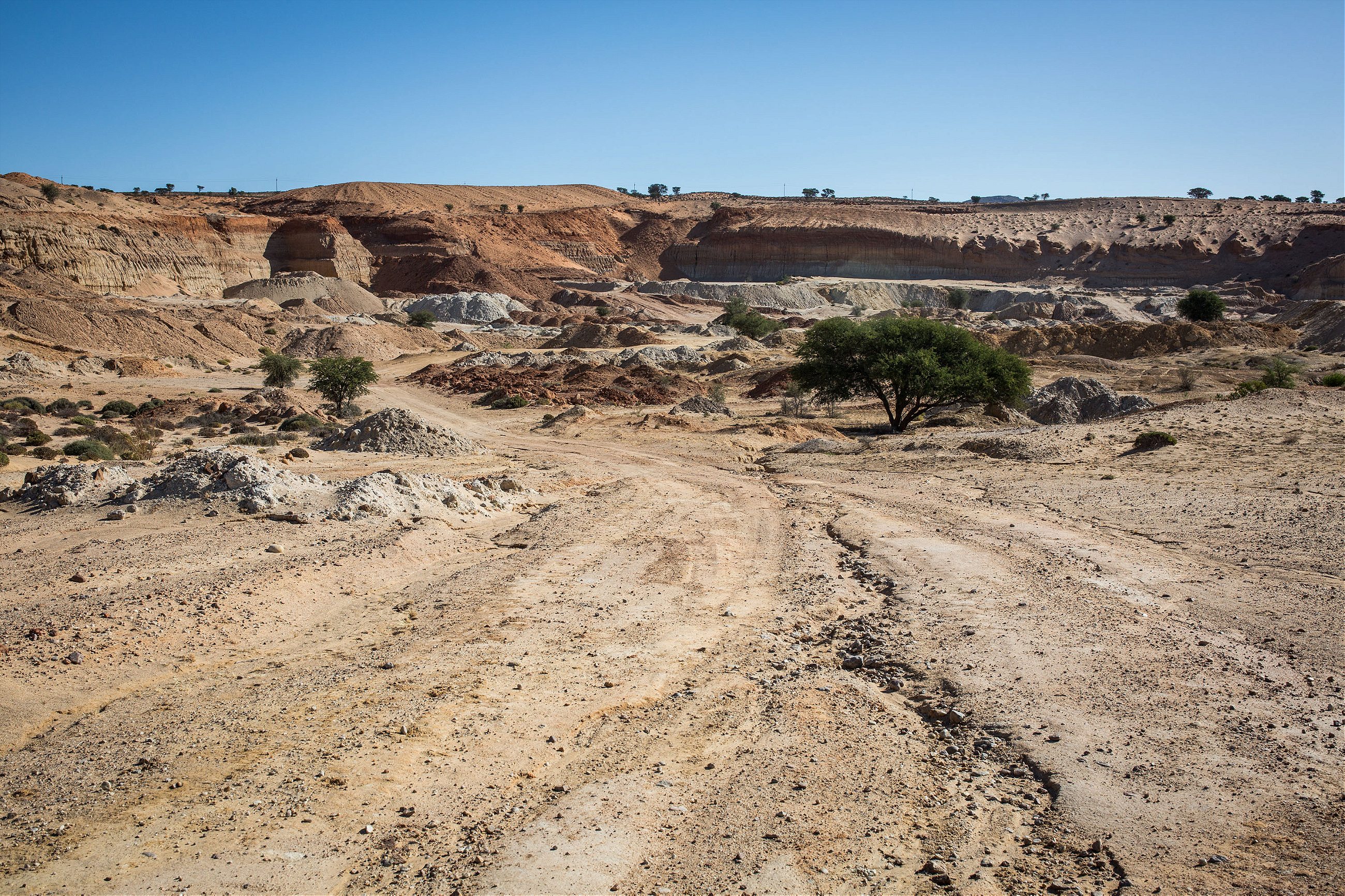
Two recent events had upset Rasta, spurring him to reveal sections of an illicit system that outsiders seldom see. The first was hearing a radio bulletin announcing harsher penalties for illegal miners in South Africa: fines of R7,000 ($500)—nine times the national poverty line, which approximately half the population fails to meet each month—or two years in jail. The same socio-economic circumstances that fuel digging in Namaqualand have produced comparable illicit markets for minerals across the country, including gold, chrome, coal, and river sand. In spite of these abundant resources, South Africa is shackled with severe unemployment and some of the highest income inequality on earth. Apartheid’s residue, expressed in quantifiable rifts between the country’s white minority and the rest of the population, remains widely visible. Coupled with lax law enforcement and the presence of powerful crime syndicates, as well as the absence of a viable small-scale mining sector, these conditions have given rise to lucrative shadow economies that the state struggles, largely in vain, to curtail.
According to the national Chamber of Mines, illicit mining is currently worth some $440 million per year in South Africa; by comparison, the legal mining industry contributes three times this figure to South Africa’s GDP. The true value of the illicit diamond trade is not known but is estimated to be worth millions of dollars annually, ultimately feeding into legal supply chains and selling in jewelry stores around the world. Though no further diamond digging deaths have been recorded since the 2012 Namaqualand collapse, at least 350 illegal miners have died across the country in the last five years, with many thousands more arrested. The prospect of meeting a similar fate has not deterred Rasta, who formerly worked for De Beers as an offshore diamond diver and first learned to dig from older miners 15 years ago.
“The gloves are off now,” Rasta says, launching into a tirade that lasts 15 minutes. He is sitting shirtless at home, a modest three-room structure with a flat tin roof. His chest knots and flexes as he speaks. “The government must see how we suffer. Fuck them! We should have permits to do this work. We could be selling our diamonds legally but instead we’re treated like thieves. A R7,000 fine! That’s bullshit.”
His argument—that artisanal miners (the technical term for miners who work informally, with simple tools) should be accommodated, not criminalized, by mining legislation—is often echoed in broader debates about mining policy in South Africa, but to date the government has been unable to enact this shift. More than any other industry, mining shaped South Africa’s historical trajectory, transforming the country from a marginal colony to the world’s largest producer of diamonds and gold. In the process, via the consolidation of labor migration and land dispossession, mining entrenched racial divisions and laid the foundations for apartheid laws. Reckoning with this legacy has proved difficult, both in practical and symbolic terms. Though black ownership has increased dramatically in the mining sector, facilitated by national Black Economic Empowerment (BEE) requirements, this has done little to address the structural basis of resource inequality. With no viable legal access to the industry, artisanal miners turn instead to illicit channels.
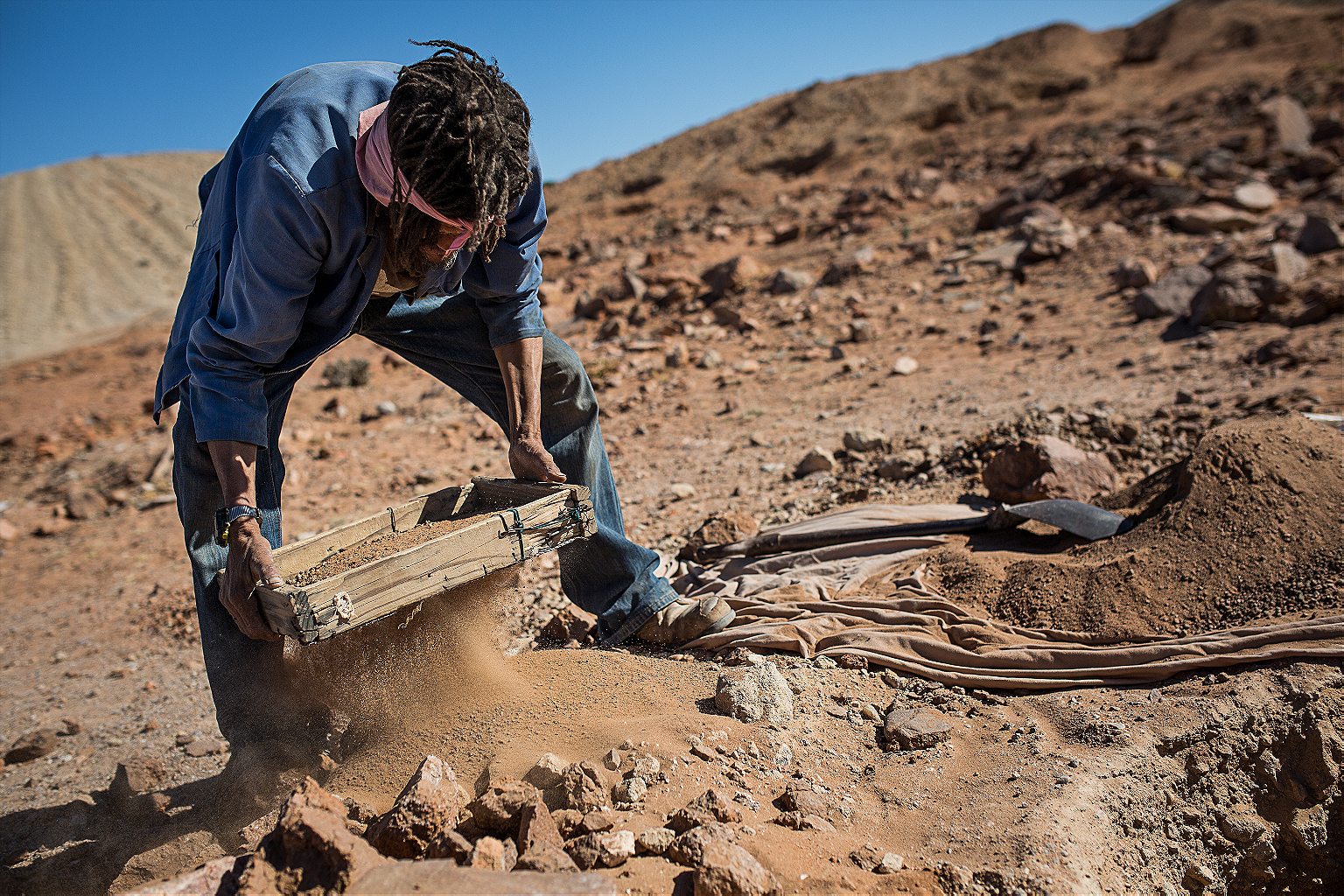
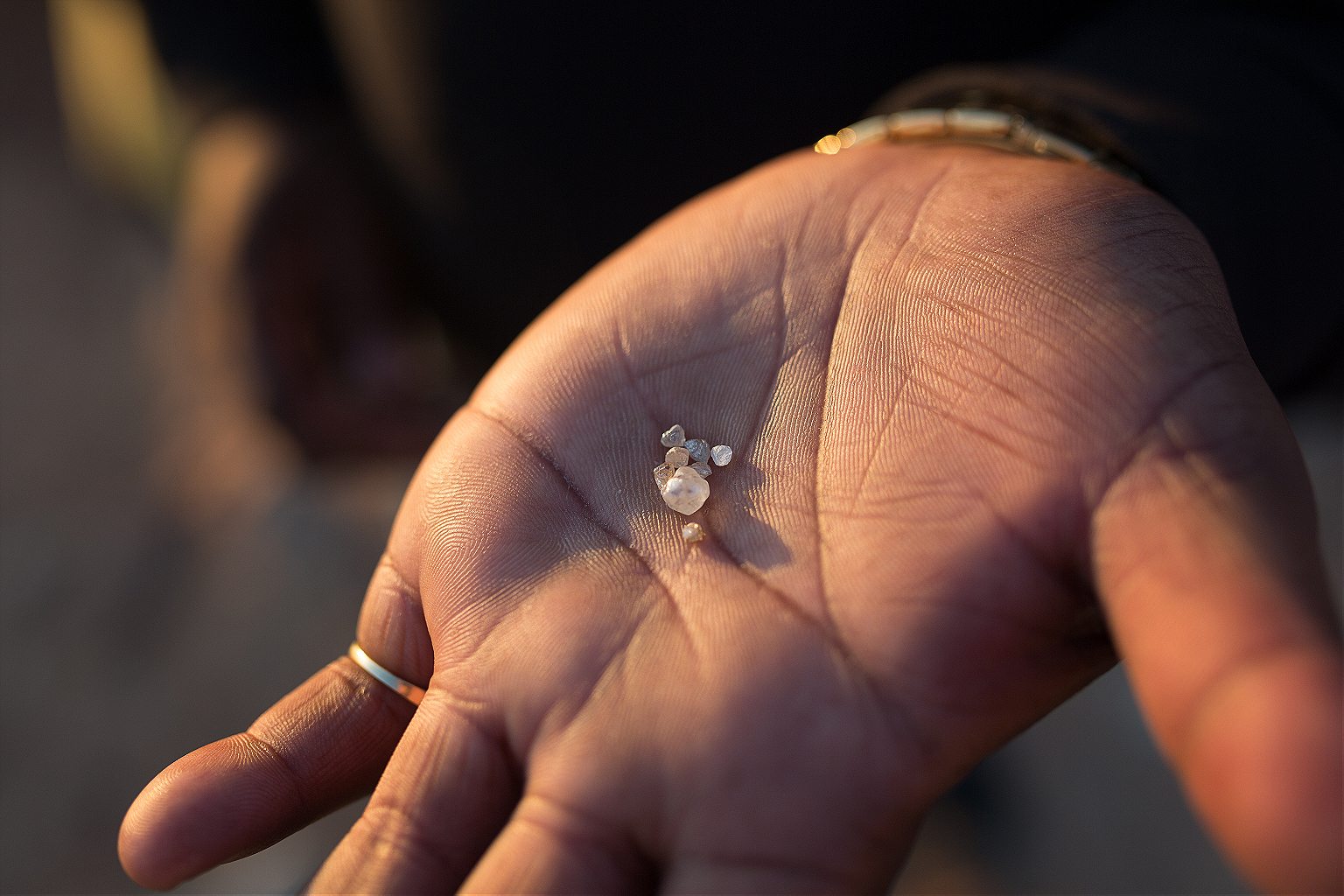
The second incident that had angered Rasta was fresher and more specific. The day before we arrived, policemen had raided a digging hotspot near Rasta’s tunnels, burning stashes of food, clothes, and blankets left behind when the miners fled. Private security companies guard the few functioning mines left in Namaqualand, but inactive sites lie open, allowing diggers to camp inside for weeks at a time. Normally, patrols in these areas fall into predictable sequences of cat and mouse: diggers scatter when police arrive, circling back soon afterwards to resume their work. At most, if caught, these diggers get charged with trespassing, receiving meager fines. By adopting a scorched earth policy, Rasta implied, the police had violated the rules of the game.
We travel to the scene of the raid the following afternoon. At the fringes of a vacant mine pit, on the banks of a dry riverbed, we meet two brothers returning from a dig. Their names are Challa and Iron. They wear torn, dusty overalls and bandanas made from rags. After their gear was burned they’d walked ten miles home to get new provisions, trekking back the very next night.
“They dragged our things into a pile and set them alight,” says Challa, gesturing towards a barren mine dump on the opposite bank. “I watched from the top of that hill. I feel heartsore. We don’t have money for more food after this.”
Our life comes from this ground
The brothers, both in their thirties, take us to see the debris. We cross a lunar expanse of land pockmarked by shallow craters: the aftermath of mining efforts by diggers unwilling to work below ground. “Those tunnels are unsafe,” says Challa. “I don’t trust them.” Instead, he and Iron, like most others in the area, merely burrow chest deep, targeting thin gravel layers just above the bedrock. Excluding short trips home to replenish their supplies, he tells me, they’ve been digging for three weeks straight without success.
A charred pair of sneakers lies amid blackened tins and shreds of fabric, shaded by a stunted thorn tree. Iron had bought them a month prior, the brothers explain: Nike Air Maxes, costing R1,000 ($75). The brothers look impassively at their former encampment, marked by a scrim of washed, discarded gravel. “Our life comes from this ground,” says Challa, turning to leave. “There’s nothing else for us to do. So we don’t stop.”
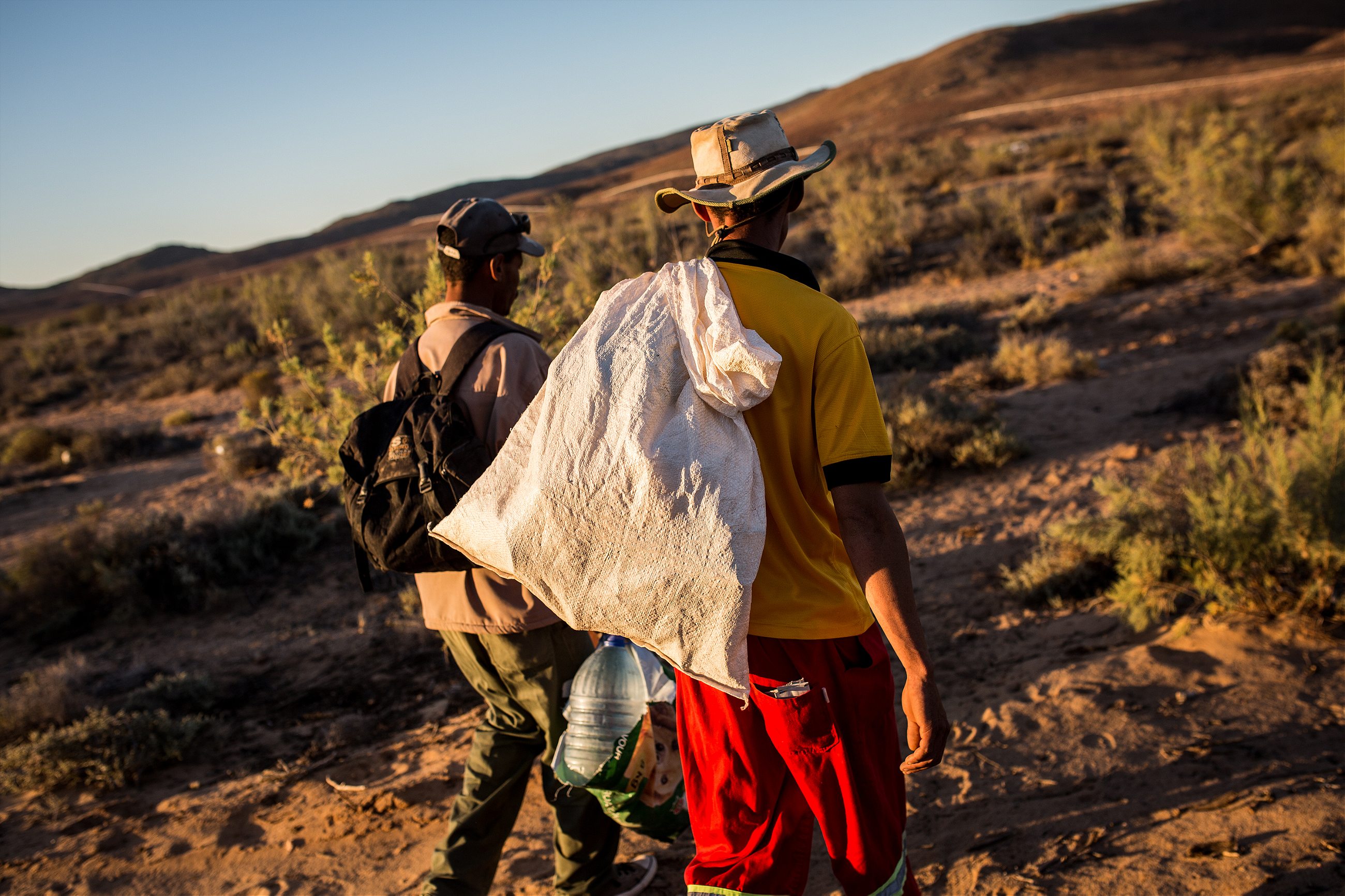
The person most directly tasked with preventing illegal digging by Rasta and his accomplices is Captain William Diergaardt, the police chief in Komaggas, a small, impoverished settlement in the heart of the Namaqualand diamond zone. In summer, a dull heat presses into the valley, as if trapped between the granite slopes. Unplastered cinderblock homes blend in with the hills; with nowhere else to go, people shelter inside or sit in pockets of shade outside the liquor stores, which open early and turn a steady trade. Wealth from the adjacent diamond mines, once among the most productive in Africa, did not accrue here, though the mines were initially established (with no compensation) on community land. Diergaardt, 48, has an ample stomach, thick mustache, and deep, authoritative voice. He was born in Komaggas, which was once home to more than than 300 De Beers employees; when the company began shutting its local operations in the early 2000s, Diergaardt’s town fell into rapid descent.
“This community has decayed,” he says, sitting in an office with crumpled maps of diamond mines on the walls. A stuffed Santa Claus suit without a face is propped beside a plastic tree in the hallway. “People used to have respect for each other here. Now children come from broken homes—there’s only one parent, or their parents are drunk all the time, or the father has no job and is too busy digging. And so the children are uncontrollable. They don’t go to school. They wander around unsupervised at night. Many start drinking underage. I’m not accustomed to this.”
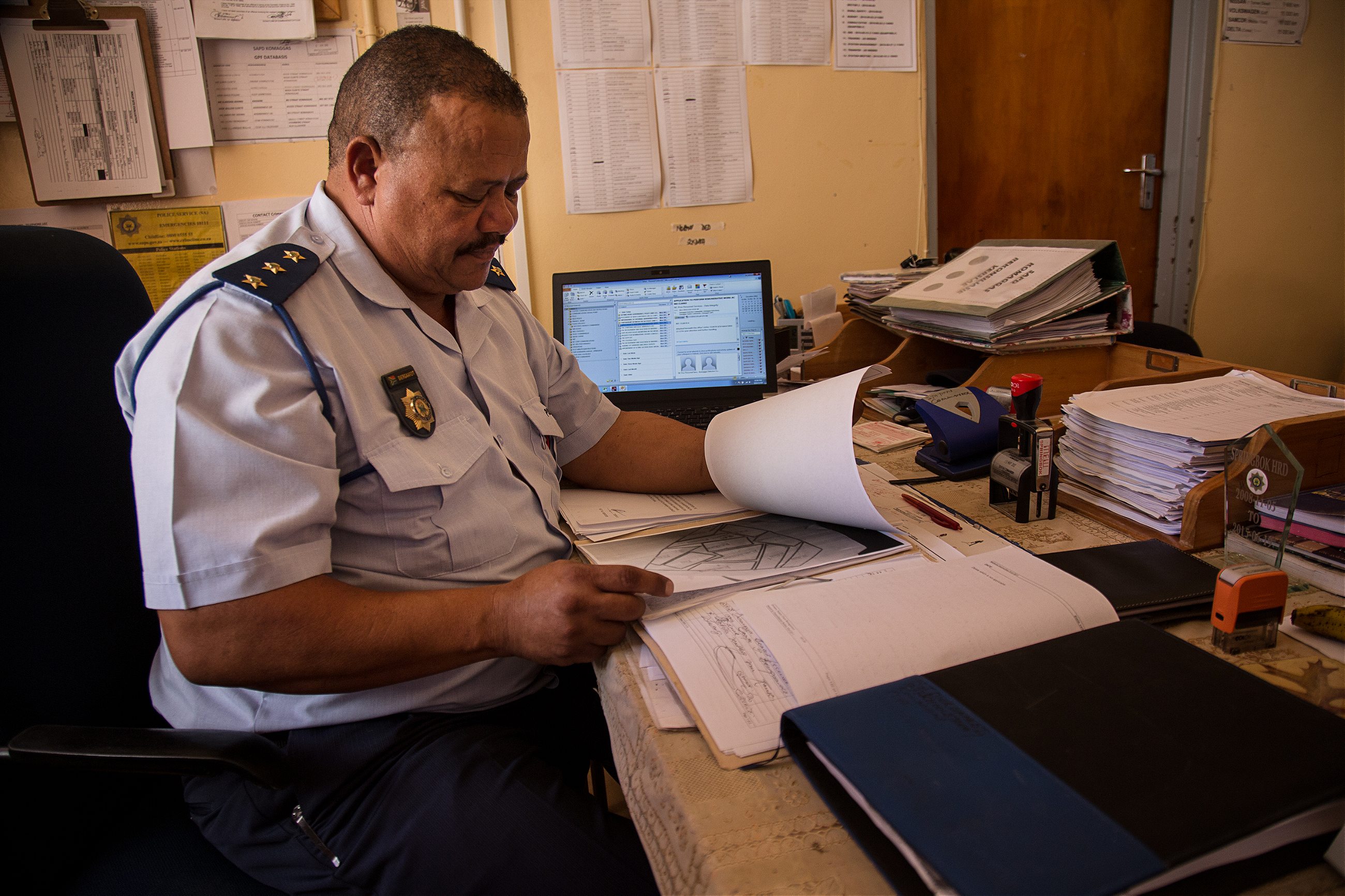
Facing a “moral downgrade” in Komaggas, with weekly stabbings and assaults—nearly all attributable to systemic alcoholism, which peaks on the first day of every month, when social security payments are made, and again at month’s end, when residents who still have jobs receive their wages—Diergaardt says that curbing diamond digging is not a priority for his station. “We don’t have the manpower,” he admits. “We’d need at least six to eight officers on duty every shift to do the job properly; we currently have four, and until recently had just two.”
Typically, his officers conduct weekly inspections of known digging locations, he says, making observations and filing reports back at the station. “It’s difficult to do more. There can be as many as 100 diggers working at once, and only two or three officers. The diggers just run away. Even if we catch them, and charge them with trespassing, the cases are often withdrawn. If they don’t pay their fines, there’s no further punishment.”
Diergaardt opens a cardboard folder containing photographs of tunnels and confiscated equipment. He had 23 trespassing cases on record between April and December, with miners fined no more than R100 each ($8). He reads from a report dated Nov. 20—“There were two women and 21 men in the shallow mine area, busy digging … we found no people at the tunnels”—and looks up from his desk to explain.
“They burrow under the old mine heaps. Those tunnels are mortally dangerous. That’s why we intervene sometimes.”
I don’t inform him that we’ve already been inside.

Before dawn on May 22, 2012, a system of tunnels caved in at a mine known as Bontekoe, about 10 miles from the area where Rasta currently works. Ten bodies were recovered during the ensuing rescue operation. Rasta had opened the tunnels, working alongside 13 other men for more than two weeks, but left three days before the collapse, after watching cracks feather across the ceiling. The Bontekoe site, at the edge of unused De Beers land, had been uncommonly bountiful, drawing hundreds of diggers; when people began carrying jackhammers down the 25-foot shaft, and pounding the supporting walls, Rasta knew that his time there was finished.
“I plant the seed, tend the plant, water it,” he tells me. “Others come to pick the fruit. Word spreads like fire when we hit a good belt. That’s just how it goes.”
People inside the mine felt rivulets of sand falling before the collapse. “It was like salt, or a thin mist,” recalled a survivor I interviewed earlier this year. His friend, Aubrey Booies, from the nearby fishing village of Hondeklip Bay, died beside him a few minutes later, crushed by boulders as the chamber imploded. “There was blood coming from his nose, his mouth, his ears—blood everywhere. I could barely make out his face. His one hand was stretched forwards, like he was trying to reach me.”
Challa, the younger of the two brothers who had their possessions burned this December, had his first and only formal job at Bontekoe, back when it was still a functioning mine. Challa enjoyed the work but found himself jobless when the mine closed in 2009. Today, he and Iron live in Buffelsrivier, a tiny, desiccated village a short drive from Komaggas, where they share a small house with their mother, who suffers from dementia, and two other brothers. We drop them at home after viewing the remnants of their destroyed camp. The next day, we return to pick them them up.
We’ve arranged to spend a night in the mine with them. (Rasta, saying vaguely that he has business to take care of, has remained at home.) A hot gale is blowing when we arrive, lifting clouds of dust from the street. Challa walks barefoot to a one-roomed store to buy food for the trip: sardines, tinned vegetables, flour, sugar, yeast. Five men share a tobacco cigarette rolled in newspaper outside his house while we wait for Iron, who arrives drunk half an hour later. Liters of cheap wine—‘Namaqua Golden Daisy’, which sells for R20 a liter ($1.50)—have narrowed his eyes to glassy slits. He slurs as we drive into the hills. By dusk, when Venus lights up the western horizon and the wind has subsided, he’s begun to grow sober.
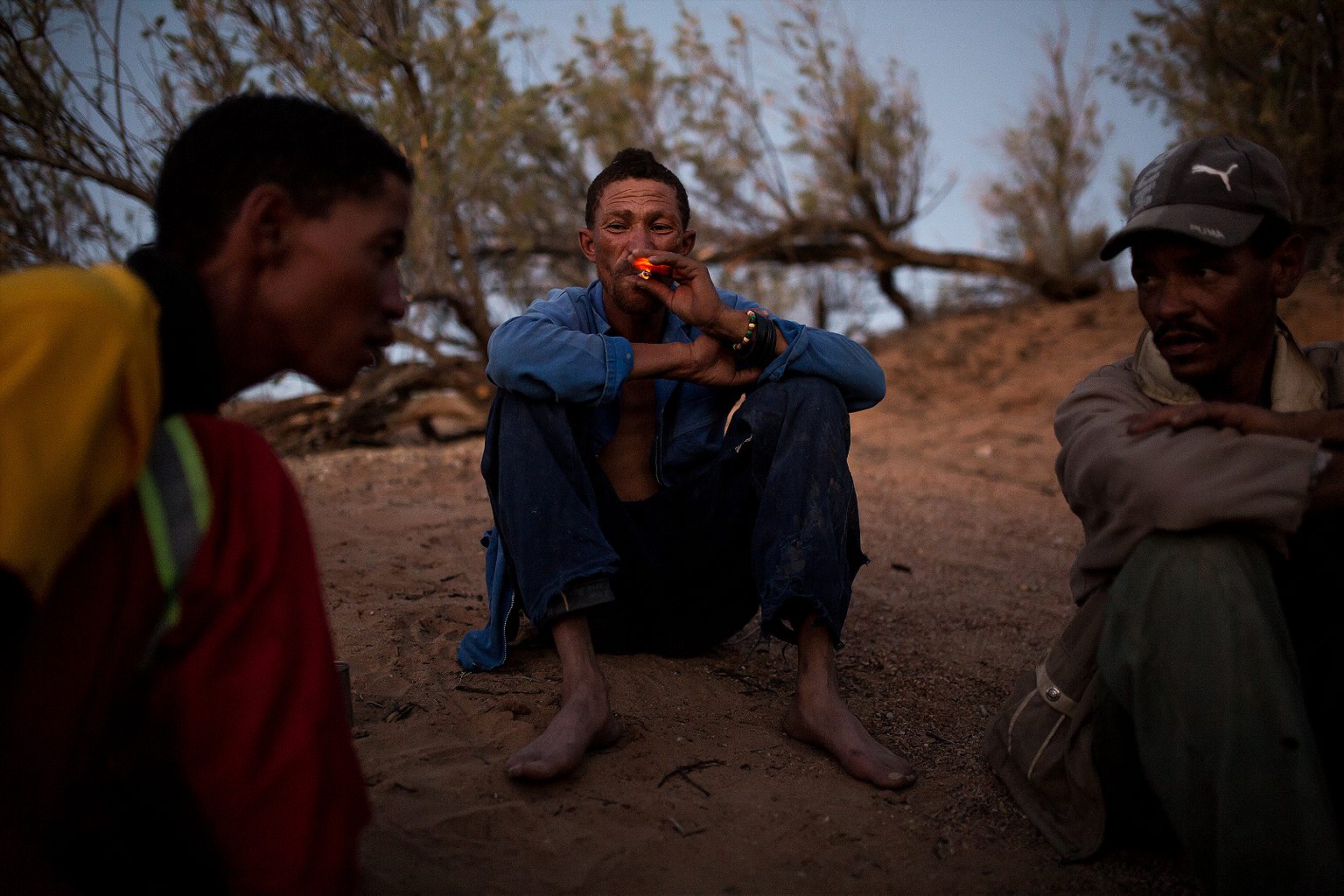
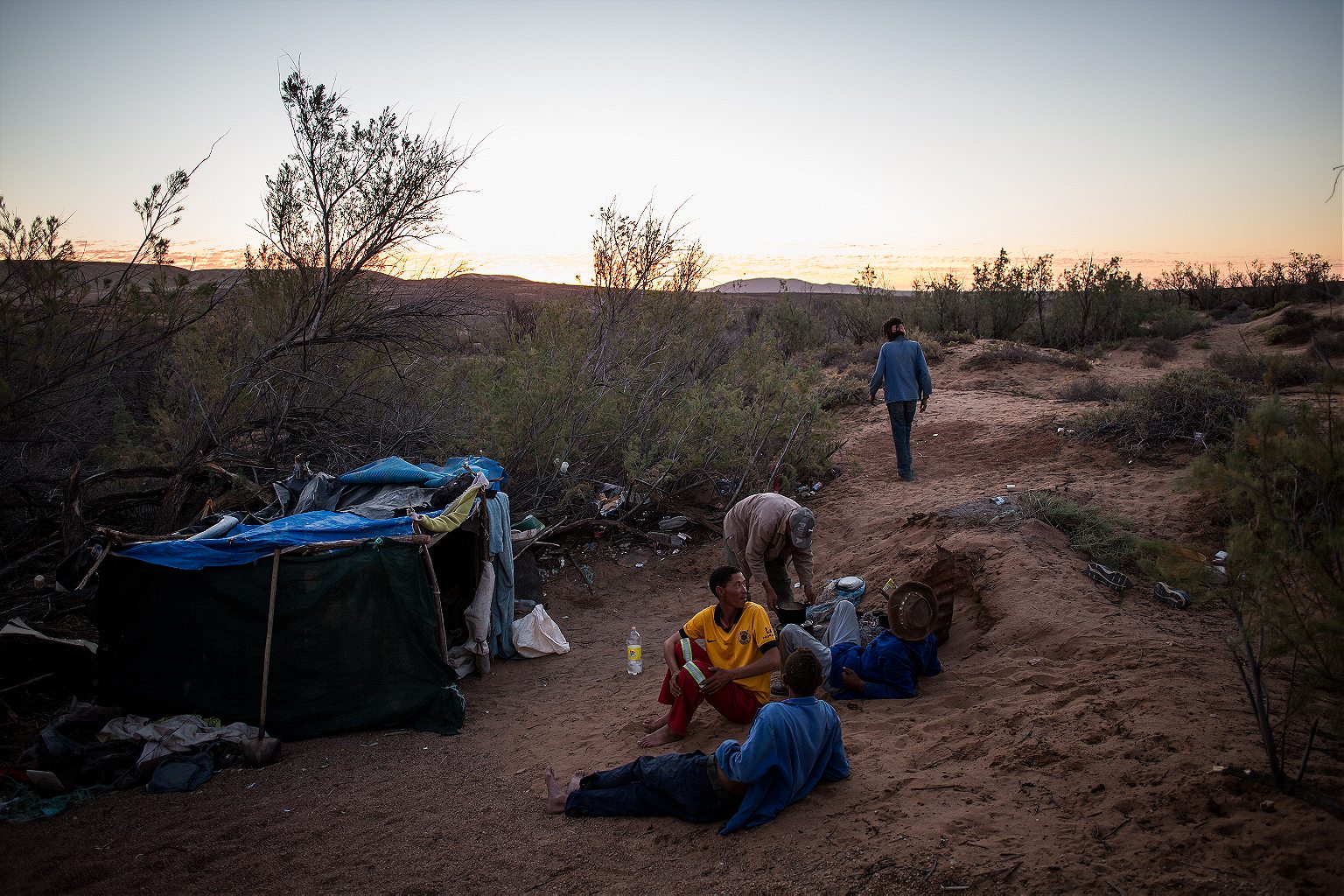
The brothers’ main camp, a rectangular shelter hidden among shrubs in the riverbed, is still intact after the police raid. (Detectives from Springbok, the nearest large town, were responsible, not Captain Diergaardt’s officers.) Ben, an accomplice who’d remained behind to keep digging, stirs a pot of “digger’s stew”—tinned vegetables, meatballs, soup mix, rice—above the fire. Iron rolls another newspaper cigarette. Stars begin puncturing the sky. Dinner is served in margarine tubs with hunks of pot bread, cooked that morning on the coals; the next day, Iron, sweating from his hangover, will knead a fresh dough and bake rolls on the rusting grid.
As darkness falls, the men smoke a glass bottleneck stuffed with marijuana, discussing their plans for a nocturnal dig. First, they need to hydrate. A pipeline runs parallel to the river, pumping freshwater to Kleinzee, a former De Beers company town (replete with overgrown rugby fields and empty hospitals) at the coast. The pipeline bypasses the Buffelsrivier settlement completely, an omission that the men, who drink brackish water at home, resent. They’d placed a bucket beneath a leak in the pipe the previous day, jumping on the seam to widen the crack, but a young cow, grazing on communal land, had knocked it over. The cow stands by as the men right the bucket, pouring the little remaining water into a muddied bottle. They decide to cancel the dig and go to sleep.
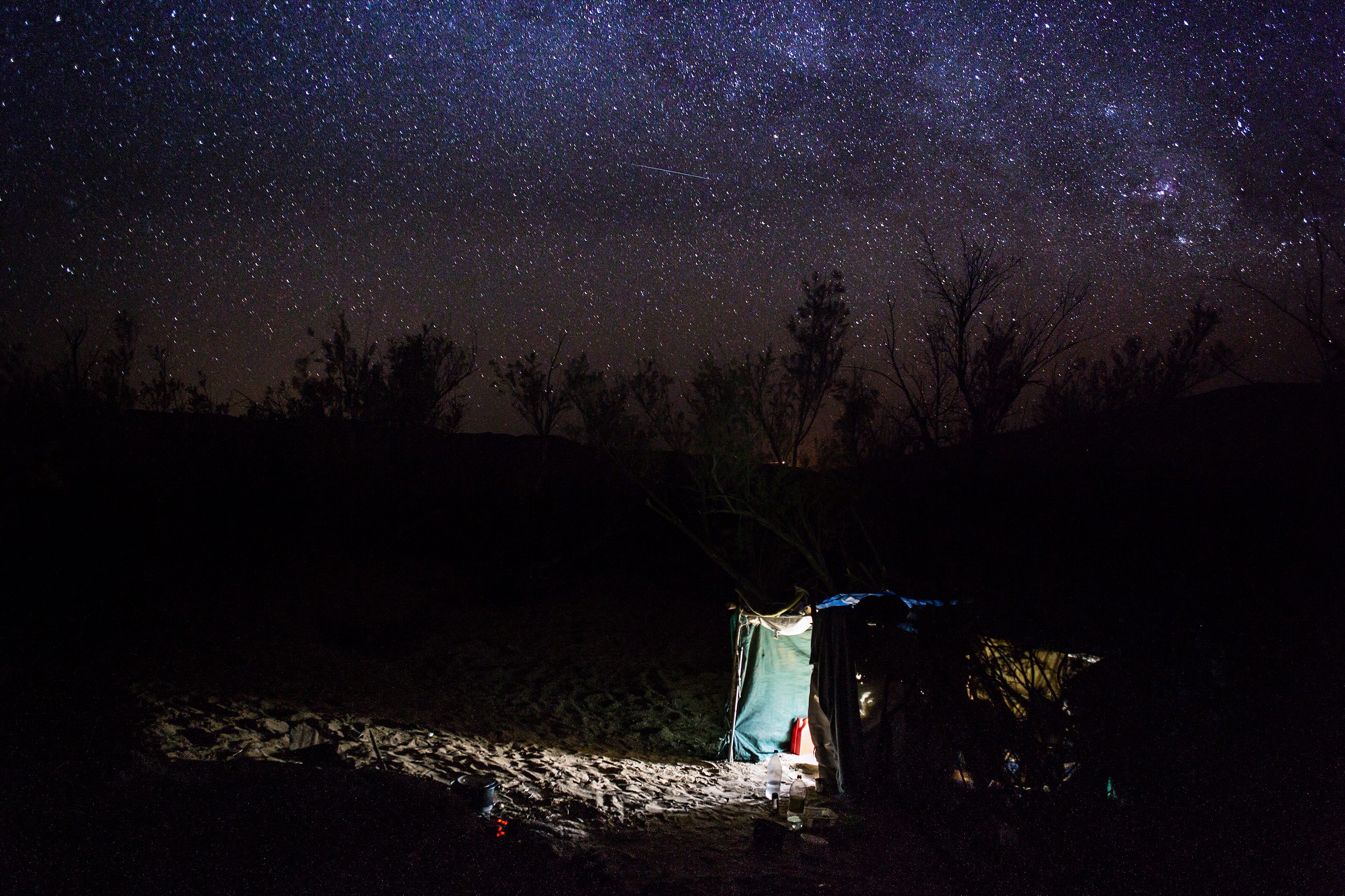
It is already hot an hour after sunrise, but the men are unhurried at their camp the next morning. Challa and Ben walk back to the pipeline while Iron tends to his bread. Other than herding sheep and goats at nomadic outposts, Iron says, his only work, other than digging for diamonds, has been building roads as a contract laborer. He complains mildly of a headache. The only solution, he explains, is “dead work” in the mine—or another plastic bottle of liquor. The others return with a small volume of water. The cow, or perhaps a feral donkey, knocked the bucket over again during the night.
They resume digging by 10 a.m., squatting in the full glare of the sun. Each sack of gravel is lifted from the hole they’ve excavated, sieved twice to remove pebbles and sand, and bagged again for washing later. At one point, Challa mentions that it is his mother’s 77th birthday; the brothers have had no money to buy her a gift. “It’s also Christmas now,” he says, hacking at the ground. “We have to find something.”
But their gravel produces no diamonds that evening. After rinsing it with dirty water in plastic drums, and picking through the concentrate in the fading light, they toss it on the ground beneath another thorn tree: one more mound of stones that does not pay.
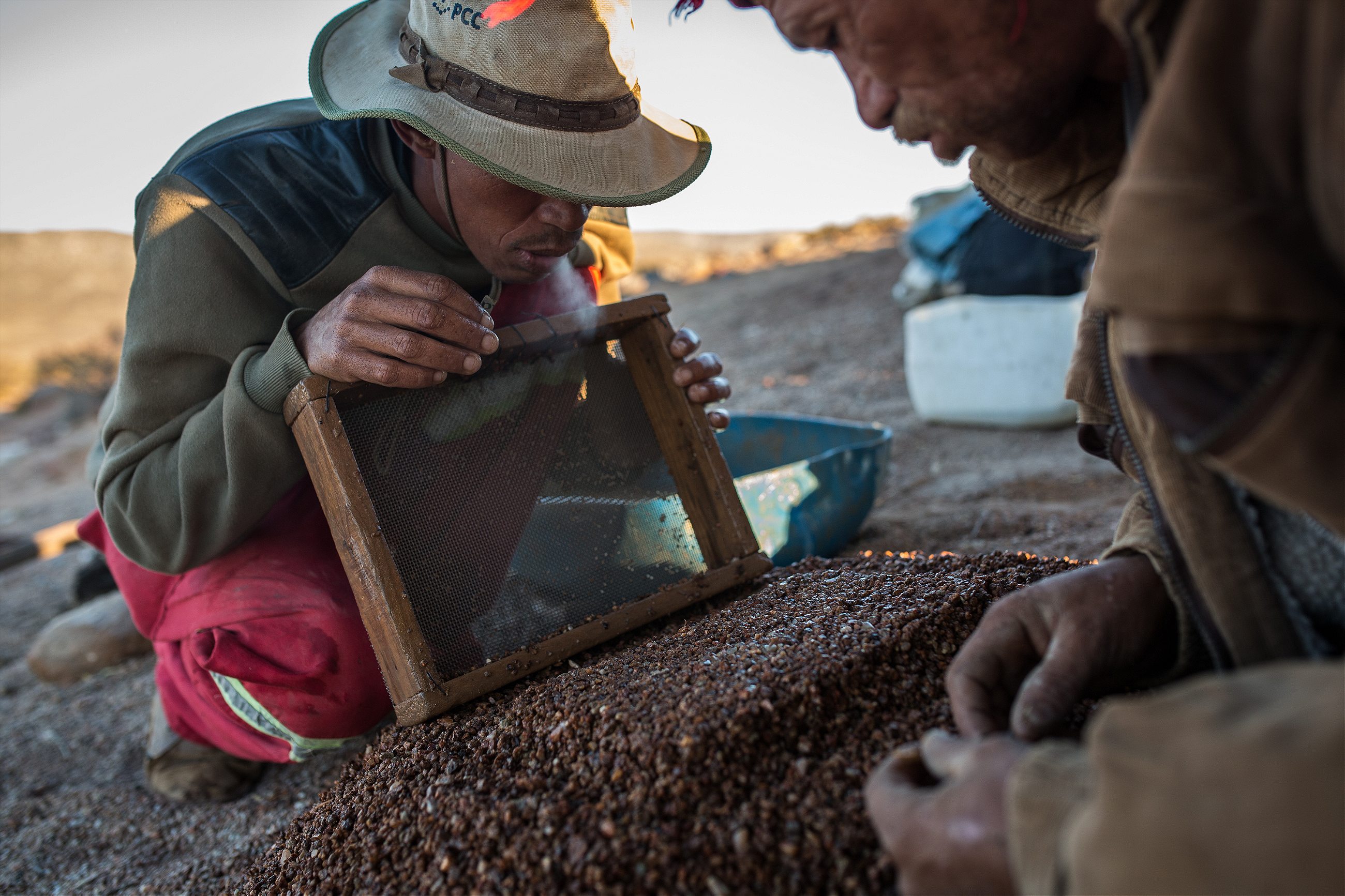
Rasta is unusually dressed the last morning I see him, replacing his threadbare shorts and tee shirt with cargo pants and leather sandals. He wears a white cap patterned with dollar bills and an embossed gold dollar sign. He is in a hurry, talking even faster than normal. “I’m leaving town for a few days to do business,” he tells me, pacing in the sand outside his front door.
This comes as a surprise. I’ve begun to think that Rasta isn’t profiting fully from his labor, losing out either to rival diggers—those who arrive to “pick the fruit” after he opens new tunnels—or the buyers controlling Namaqualand’s illicit supply chains. Rasta has reputedly uncovered hundreds of stones but still lives in poverty; the most expensive possession of his I’ve seen is an ancient television connected to a subscription-service satellite dish. He also owns a German sedan that broke down shortly after he purchased it, and has eight children with eight different mothers, but this doesn’t seem enough to account for his lack of visible wealth. Hearing that he has a second, more furtive line of work compounds the puzzle.
“I work with money,” he says, refusing to divulge further. “When I’m here, I’m a digger; I’m a different person in the city.”
It’s their job to arrest me—and it’s my job to get away
Several men I don’t recognize are sitting inside the house. Rasta’s main buyer arrives and ducks through the door to take a seat. It looks like their meeting is about to start, but Rasta keeps talking. It strikes me that he relishes having an audience. He seems unable to stop. Then a police van pulls up and he jogs over, leaning through the driver’s window. “They said you visited the station yesterday,” he says when the cops leave. I’m concerned this interaction might have alarmed Rasta, but when I ask him he just laughs. “They know what I do but they have nothing on me,” he says. “They haven’t caught me digging or with diamonds once.”
I want to know more about the deal he is working on, and what he does with his money, but the men inside are watching us closely; instead, I ask Rasta why he looked so comfortable with the police. “If they respect me, I respect them,” he says, before his buyer calls him over. He straightens his cap over his dreadlocks and moves toward the house. I will learn no more from him on this trip. “They protect you, but they also try catch you. It’s their job to arrest me—and it’s my job to get away.”